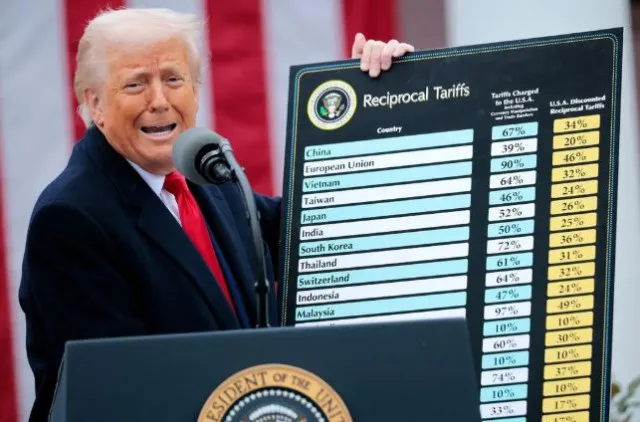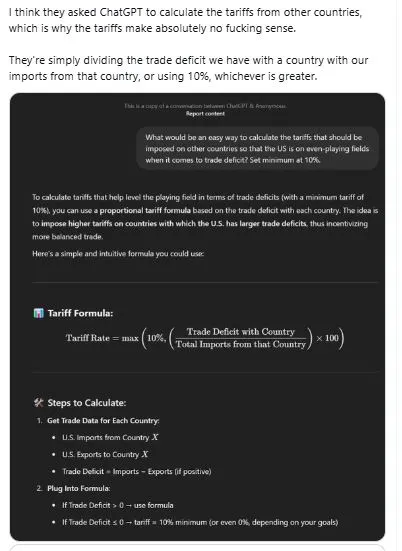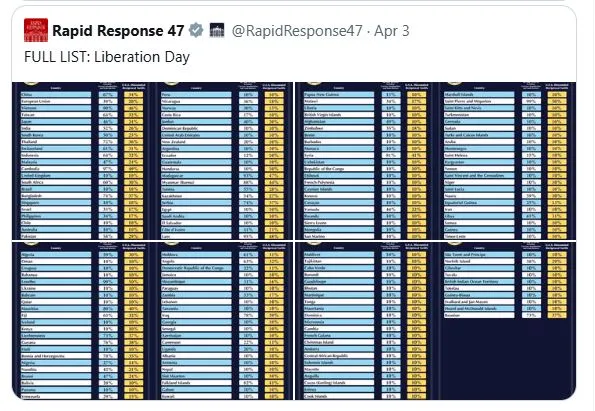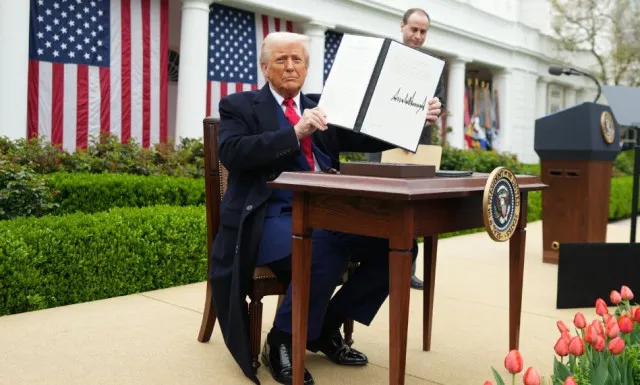President Donald Trump has unveiled sweeping new tariffs affecting nearly every nation. But critics now claim the plan may have come from ChatGPT.
Observers are questioning the logic behind the percentages.
Many believe the numbers lack a clear economic foundation. One viral theory suggests Trump’s team used artificial intelligence—specifically ChatGPT—to decide on the rates.
Trump announces global tariffs with no country left untouched
On April 2, 2025, Trump announced major new trade tariffs.

Almost every country faces at least a 10% tariff on exports to the U.S. Some countries, like Vietnam, received much higher rates.
Vietnam now faces a 46% tariff on its exports to the U.S.
Even uninhabited territories have not been spared.
The announcement shocked world leaders and economists alike.
It raised urgent questions about how these rates were calculated.
Economist claims Trump’s tariff math makes no economic sense
James Surowiecki, a respected financial journalist, weighed in on social media.

On X platform, he posted a breakdown of the math behind the tariffs.
Surowiecki believes the Trump team used trade deficit figures in reverse. He wrote on X: “Just figured out where these fake tariff rates come from.
“They didn’t actually calculate tariff rates + non-tariff barriers, as they say they did. Instead, for every country, they just took our trade deficit with that country and divided it by the country’s exports to us.
“So we have a $17.9 billion trade deficit with Indonesia. Its exports to us are $28 billion. $17.9/$28 = 64%, which Trump claims is the tariff rate Indonesia charges us. What extraordinary nonsense this is.”
This approach lacks economic grounding and misrepresents how tariffs typically work.

As an example, he cited Indonesia. The U.S. trade deficit with Indonesia is $17.9 billion.
Indonesia exports $28 billion in goods to the U.S. Dividing $17.9B by $28B gives 64%, which is now Indonesia’s tariff rate.
Surowiecki called this logic “extraordinary nonsense.”
He believes the numbers were not grounded in trade theory or policy.
Social media claims ChatGPT helped shape Trump’s tariff policy
The internet quickly latched onto a surprising theory.
Some users claimed the tariff formula looks like an AI-generated response. One viral tweet suggested Trump’s team asked ChatGPT for help. While, they even shared a screenshot of a ChatGPT conversation.
One person said: Humans couldn’t even be bothered to fact check the output. Too busy golfing I guess.
A second wrote: No, retard.
While a third commened: You can tell they used Ai , they put tarrifs on islands that don’t even have people on them.
Sounds like someone accidentally hit “reply all” with their homework. Another added.
Someone else said: Donald Trump must be removed from office to save our country.
it’s called “Vibe Governing” Someone else said.
In it, a user asked how to level trade deficits using tariffs. They told the bot to “set a minimum at 10%.” ChatGPT responded with a formula similar to Trump’s plan.
The bot advised using proportional tariffs based on trade deficits.

It explained that countries with larger deficits should face higher tariffs.
According to World Population Review, the U.S. has the biggest deficits with China, Mexico, and Vietnam.
These nations were all hit with some of the steepest tariffs.
Critics ay tariff logic is flawed and will hurt the U.S. economy
Economists warn the new tariffs could backfire. Higher costs on imported goods will affect American consumers.
Retaliatory tariffs from other countries could harm U.S. exporters. Analysts also point out that tariffs based on trade deficits are overly simplistic.
Trade deficits aren’t inherently bad or good, experts note.
They reflect complex global supply chains and consumer demand. Using them as a base for tariffs ignores key economic realities.